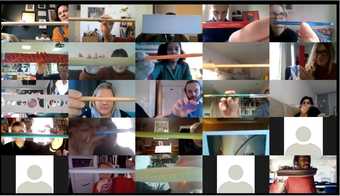Supervised by Professor Pat Thomson, University of Nottingham and Emily Pringle, Head of Research, Tate
October 2019 –

Screenshot from an online artist-led CPD session for primary school teachers
Prior to the pandemic, Tate offered immersive professional learning for teachers; supported school visits and artist produced resources; and participation in artist-led workshops and projects. These resources provided an interconnected offer for schools. The offer sought to support pupils to engage with art in the galleries. However, during the pandemic, with the closure of the galleries, physically being with art was not possible for a significant period of time.
This research explores how the Schools and Teachers team adapted their practice during this period to provide opportunities for schools to engage with art and art practice. This includes looking at an increased use of digital media to communicate with the audience and to deliver programme, for example CPD.
The Covid-19 pandemic period has been one of intense pressure for both schools and Tate, this research explores what the value of artist-led pedagogies is for pupils in this period.
It is anticipated that this research will contribute to the growing area of research on the impact of the pandemic on art education, as well as contributing to current thinking on the significance of art museums, art and artistic practice and their relationship with schools.
How did you come to be researching this subject?
I am interested in how art museums can best support schools to increase opportunities for creative learning, art and exciting experiences. I believe that creative pedagogies have much to offer throughout the curriculum and have the potential to create beneficial and transformative learning experiences. The Covid-19 pandemic has offered a unique opportunity to research how Tate’s programme, that took place entirely in-gallery prior to the pandemic, has changed to respond to the needs of schools, teachers and their pupils.
